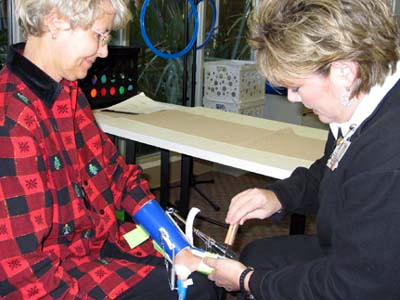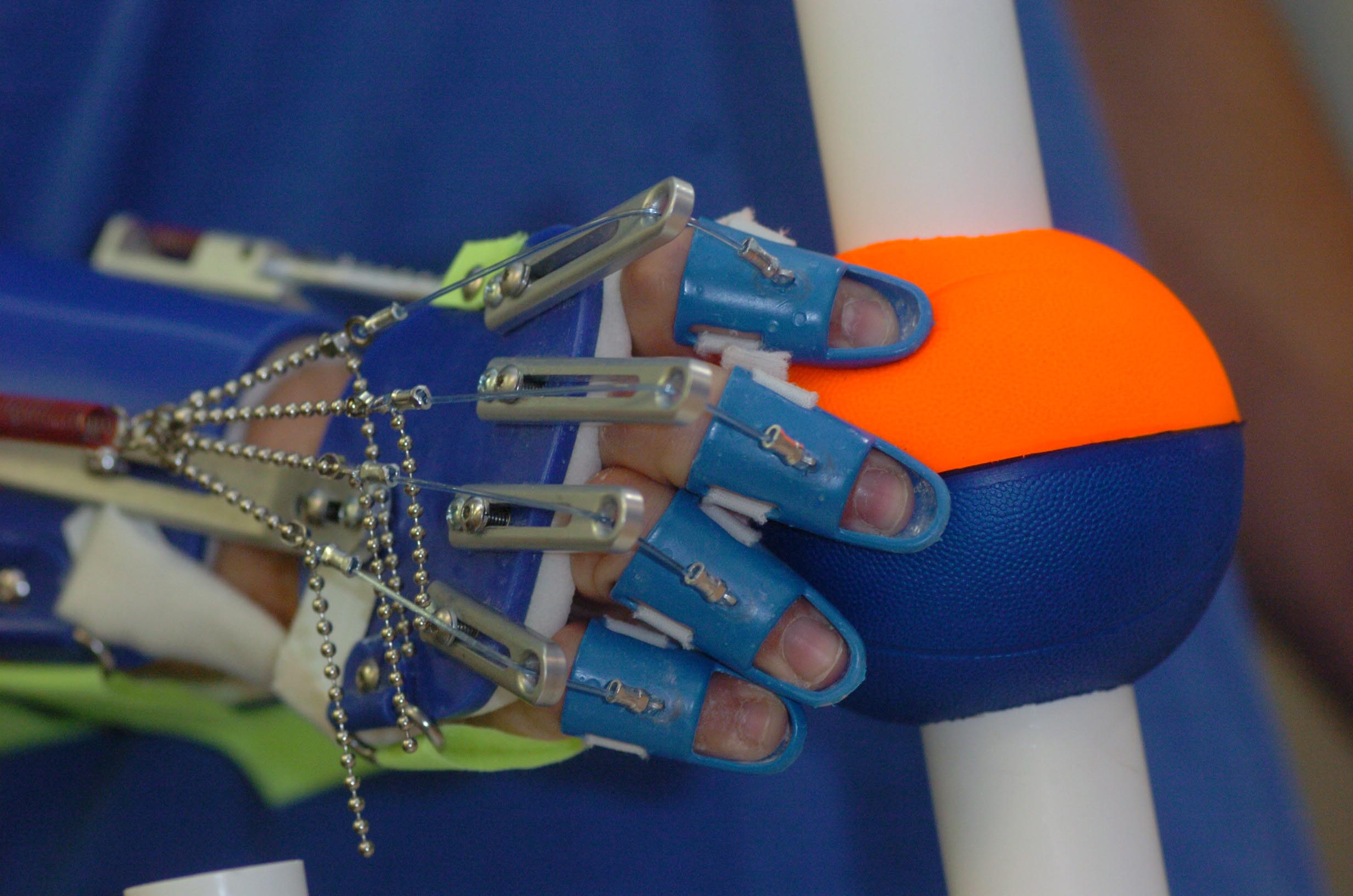Flowood, Miss.—Polly Roberts used to look at her clenched left fist with a sense of resignation.
She figured it was futile to hope for further recovery from the 1999 stroke that left her hand so constricted she couldn’t pull up her own bed covers. “You reach a plateau where they say it’s as good as it’s going to be,” said the 76-year-old Brandon resident.
So she has been happily surprised by the progress she is making at Methodist Rehabilitation Center’s outpatient clinic on the Jackson hospital’s east campus in Flowood. Thanks to an innovative therapy known as Functional Tone Management Arm Training, Roberts can now use her left hand for everything from picking up paper clips to loading laundry.
Methodist occupational therapist Peggy Kelly says Roberts’ transformation was made possible by a recently developed splint called the SaeboFlex. The spring-loaded device helps people with little or no hand control extend their thumbs and fingers, thus providing a means to practice grasping and releasing objects.
Patients in the training program perform a series of task-oriented drills that are designed to exercise specific muscle groups. “Some are done with the splint on, and some without,” Kelly said. “As the patient improves, the tasks become more complex.”
As a result of the therapy, many victims of neurological injury are reclaiming abilities they thought were forever lost. “For months and months, I couldn’t open my hand,” Roberts said. “I didn’t know there was such a thing as getting better.”
It’s not surprising that stroke survivors have learned not to count on continued improvement. “The general consensus has been that whatever function you’ve got 18 months post-stroke is what you’re going to have,” Kelly said.
But with new research showing that the brain has the capacity to rewire long after a neurological injury, Kelly said innovations like the SaeboFlex are hitting the market at the right time. “We used to run out of things to do with patients other than to say: Go home and use the affected limb as much as you can. Now we have access to a therapy that has been shown to help restore function up to 20 years post-injury.”
Kelly was the first Mississippi therapist to receive advanced SaeboFlex training. Impressed by the program’s results, she began contacting former patients she thought would qualify for the therapy, which is covered by many insurance plans.
“When Peggy called to let me know I had met the criteria, I was excited,” said Lily Wheeler, 59, of Star, who suffered two strokes in October, 2000. “You want to try whatever you think might help.”
Wheeler was initially taken aback by the splint’s futuristic look. “When I saw the contraption—it was like a bionic arm,” she said. “But anything you can do to get your quality of life back is worth it. I couldn’t do anything with my left arm and hand—they just hung there.”
Kelly said Wheeler and Roberts are good candidates for the therapy because even though they can raise their arms and bend their elbows, they’ve been limited by an inability to extend their arms and fingers.
Both women have made steady progress since beginning therapy. When Wheeler first started, she could barely pick up silverware. Now she can set the table, type on her computer keyboard and style her hair with a blow dryer and curling iron.
Kelly said Roberts also has gotten control of fingers that previously had “a mind of their own.” Once again she is using her left hand to flick on light switches, pull open the refrigerator door and even pick up packets of sweetener.
While most people take the ability to do such simple tasks for granted, Kelly says they are treasured skills for people who have been disabled by neurological injuries. “When Polly says she opened a packet of Splenda by herself, people might think: Big deal. But that means she can have a cup of coffee by herself or pull the covers up in bed without having to wake her husband to do it.”
In addition to improving motor skills, Kelly said the exercises done during therapy with SaeboFlex also seem to help balance and strength. “It has given me enough confidence to leave my cane at home,” Roberts said.
Wheeler’s successes also have encouraged her to try new challenges. And she’s hoping her experience will inspire others who fear they’ve reached the limits of their recovery. “They need hope because they mostly hear about people who don’t get better,” she said. “They don’t know they can get their quality of life back. I have made volumes of progress.”
For more information on the Functional Tone Management Arm Training program, call Susan Geiger at 601-936-8888.


